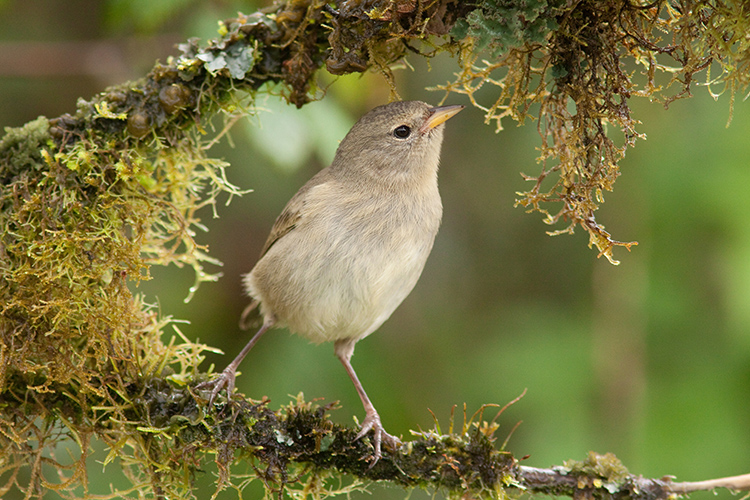Base de Datos de las Especies de Galápagos
La Base de Datos de las Especies de Galápagos comparte la información de las especies de nuestras Colecciones de Historia Natural.
Certhidea fusca
Pinzón Reinita Gris, Pinzón cantor gris, Gray Warbler Finch

Es el pinzón más pequeño (aprox. 8 gramos) y con el pico más fino.
Información adicional Venegas, L.
Dominio
Eukaryota
Reino
Animalia
Filo
Chordata
Clase
Aves
Orden
Passeriformes
Familia
Thraupidae
Género
Certhidea
Especie
fusca
Categoría de taxón: Aceptado
This species is closely related to the Green Warbler Finch, and were formerly considered conspecific, but both species differed in appearance, distribution, habitat, and song. Syn.: Certhidea olivacea Gould, 1837. A recent genetic study has shown a single colonization event about 850 000 yrs ago from southern central America rather than continental Ecuador.
Origen del taxón: Endémica
Preferencia de zona de altitúd en Galápagos: Zona seca - zona de transición
Preferencias de habitat: Se encuentra en zonas un poco más secas que C. olivacea, el otro pinzón cantor.
Preferencias de substrato o huésped: Forrajea en los árboles y arbustos buscando artrópodos, explora el follaje, busca en los musgos (sobre todo en temporada seca), busca en hojas terminales y epífitas.
Papel trófico: Carnívoro
Biología reproductiva: El macho se exhibe en frente de un nido cerrado que construye solo. Cuando la hembra lo escoge como pareja , usan este nido, o los dos construyen uno nuevo. La hembra pone 2-3 huevos, incuba sola pero ambos alimentan los pichones. Cada pichón se queda con uno de los padres hasta 6 semanas.
Distribución: Presente en las pequeñas islas del norte, este y sur del archipiélago, Darwin, Wolf, Española, Santa Fe, San Cristobal, Pinta y Floreana.
- Wiedenfeld, D.A. (2006) Aves, the Galapagos Islands, Ecuador. Check List 2006 2(2): 1-27.
- Harris, M.P. (1973) The Galápagos avifauna. Condor 75(3): 265-278.
- Salvin, O. (1876) On the avifauna of the Galápagos Archipelago. Transactions of the Zoological Society of London 9: 447-510.
- Castro, I. Phillips, A. (1996) A Guide to the Birds of the Galapagos Islands. Christopher Helm Publishers Ltd., London.
- Swarth, H.S. (1931) The Avifauna of the Galapagos Islands. Occ. Pap. Calif. Acad. Sci. 18: 1-299.
- Guerrero, A. Tye, A. (2009) Darwin's Finches as seed predators and dispersers. The Wilson Journal Of Ornithology 121 (4):752-764, 2009
- Remsen, J.V Cadena, C. D., Jaramillo, A., Nores, M., Pacheco, J. F., Pérez-Emán, J., Robbins, M. B., Stiles, F. G., Stotz, D. F., and Zimmer, K. J. (2012) A classification of the bird species of South America. American Ornithologists' Union http://www.museum.lsu.edu/~Remsen/SACCBaseline.html
- Farrington, H. Petren, K. (2011) A century of genetic change and metapopulation dynamics in the Galápagos warbler finches (Certhidea). Evolution 65:3148-3161.
- Grant, B.R. Grant, P.R. (2002) Lack of premating isolation at the base of a phylogenic tree. The American Naturalist 160:1-19.
- Grant, P.R. Grant, B., Petren, K. & Keller, L (2005) Extinction behind our backs: the possible fate of one of the Darwin's finch species on Isla Floreana, Galápagos. Biological Conservation 122:499-503.
- Petren, K. Grant, B. & Grant, P. (1999) A phylogeny of Darwin's finches based on microsatellite DNA length variation. Proceedings of the Royal Society of London Series B-Biological Sciences 266:321-329.
- Petren, K. Grant, P., Grant, B. & Keller, L. (2005) Comparative landscape genetics and the adaptive radiation of Darwin’s finches: the role of peripheral isolation. Molecular Ecology 14:2943-2957.
- Tonnis, B. Grant, P., Grant, B. & Petren, K. (2005) Habitat selection and ecological speciation in Galápagos warbler finches (Certhidea olivacea and Certhidea fusca). Proceedings of the Royal Society of London Series B-Biological Sciences 272:819-826.
- Farrington, H. Lawson, L., Clark, C. & Petren, K. (2014) The evolutionary history of Darwin's finches: speciation, gene flow, and introgression in a fragmented landscape. Evolution doi 10.1111/evo.12484.
- IUCN (2015) The IUCN Red List of Threatened Species. Version 2015-4. <www.iucnredlist.org>. Downloaded on 20 November 2015.
- Lamichhaney, S. Berglund, J., Sällman Almén, M., Maqbool, K., Grabherr, M., Martinez-Barrio, A., Promerova, M., Rubin, C.J., Wang, C., Zamani, N., Grant, B.R., Grant, P.R., Webster, M.T., Andersson, L. (2015) Evolution of Darwin’s finches and their beaks revealed by genome sequencing Nature 518: 371-386. doi:10.1038/nature14181
- Remsen, J.V. Areta, J.I.Jr., Cadena, C.D., Claramunt, S., Jaramillo, A., Pacheco, J.F., Pérez-Emán, J., Robbins, M.B., Stiles, F.G., Stotz, D.F., Zimmer, K. J. (2016) A Classification of the Bird Species of South America. South American Classification Committee. American Ornithologists' Union http://www.museum.lsu.edu/~Remsen/SACCBaseline.htm
- IUCN (2017) The IUCN Red List of Threatened Species Version 2016-3. <www.iucnredlist.org>. Downloaded on 03 February 2017.
- Freile, J.F. Santander, T., Jiménez-Uzcátegui, G., Carrasco, L., Cisneros-Heredia, D., Guevara, E., Sánchez-Nivicela, M., Tinoco, B. (2019) Lista Roja de las aves del Ecuador Quito, Ecuador. 97 pp.



Tipo de alimentación: Insectívoro